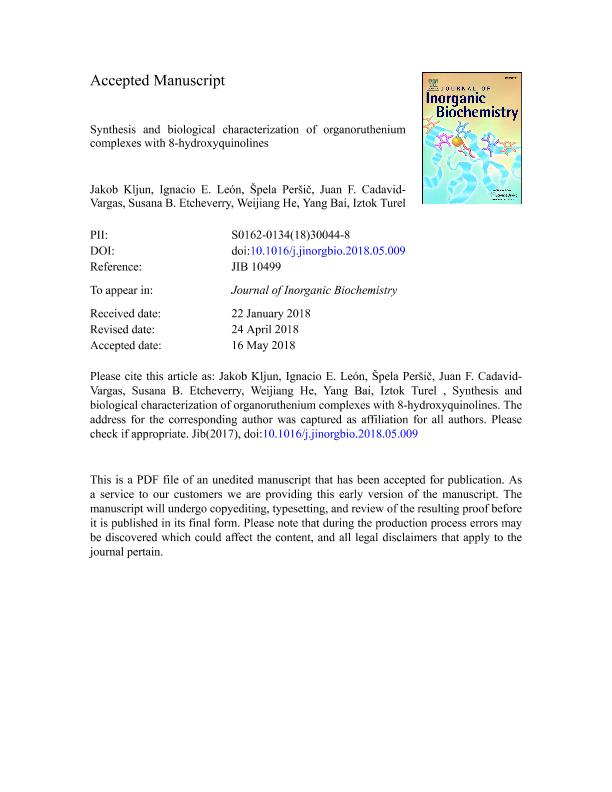Mostrar el registro sencillo del ítem
dc.contributor.author
Kljun, Jakob
dc.contributor.author
Leon, Ignacio Esteban

dc.contributor.author
Pervi, Spela
dc.contributor.author
Cadavid Vargas, Juan Fernando

dc.contributor.author
Etcheverry, Susana Beatriz

dc.contributor.author
He, Weijiang
dc.contributor.author
Bai, Yang
dc.contributor.author
Turel, Iztok
dc.date.available
2019-10-29T16:51:48Z
dc.date.issued
2018-09
dc.identifier.citation
Kljun, Jakob; Leon, Ignacio Esteban; Pervi, Spela; Cadavid Vargas, Juan Fernando; Etcheverry, Susana Beatriz; et al.; Synthesis and biological characterization of organoruthenium complexes with 8-hydroxyquinolines; Elsevier Science Inc; Journal of Inorganic Biochemistry; 186; 9-2018; 187-196
dc.identifier.issn
0162-0134
dc.identifier.uri
http://hdl.handle.net/11336/87546
dc.description.abstract
In this study we report the synthesis, characterization and a thorough biological evaluation of twelve organoruthenium?8-hydroxyquinolinato (Ru-hq) complexes. The chosen hqH ligands bear various halogen atoms in different positions which enables to study effect of the substituents on physico-chemical and biological properties. The determined crystal structures of novel complexes expectedly show the cymene ring, a bidentately coordinated deprotonated hq and a halide ligand (chlorido or iodido) coordinated to the ruthenium central ion. In previous studies the anticancer potential of organoruthenium complex with 8-hydroxyquinoline ligand clioquinol was well established and we have decided to perform an extended biological evaluation (antibacterial and antitumor activity) of the whole series of halo-substituted analogs. Beside the cytotoxic potential of studied compounds also the effect of two selected complexes (9 and 10) on apoptosis induction in MG-63 and A549 cells was also studied via externalization of phosphatidylserine at the outer plasma membrane leaflet. Both selected complexes that gave best preliminary cytotoxicity results contain bromo substituted hq ligands. Apoptosis induction results are in agreement with the cell viability assays suggesting the higher and more selective anticancer activity of complex 10 in comparison to complex 9 on MG-63 cells.
dc.format
application/pdf
dc.language.iso
eng
dc.publisher
Elsevier Science Inc

dc.rights
info:eu-repo/semantics/openAccess
dc.rights.uri
https://creativecommons.org/licenses/by-nc-sa/2.5/ar/
dc.subject
QUINOLINES
dc.subject
RUTHENIUM
dc.subject
CANCER
dc.subject
COMPLEXES
dc.subject.classification
Biología Celular, Microbiología

dc.subject.classification
Ciencias Biológicas

dc.subject.classification
CIENCIAS NATURALES Y EXACTAS

dc.title
Synthesis and biological characterization of organoruthenium complexes with 8-hydroxyquinolines
dc.type
info:eu-repo/semantics/article
dc.type
info:ar-repo/semantics/artículo
dc.type
info:eu-repo/semantics/publishedVersion
dc.date.updated
2019-10-22T16:42:54Z
dc.journal.volume
186
dc.journal.pagination
187-196
dc.journal.pais
Estados Unidos

dc.description.fil
Fil: Kljun, Jakob. University of Ljubljana; Eslovenia
dc.description.fil
Fil: Leon, Ignacio Esteban. Universidad Nacional de La Plata. Facultad de Ciencias Exactas; Argentina
dc.description.fil
Fil: Pervi, Spela. University of Ljubljana; Eslovenia
dc.description.fil
Fil: Cadavid Vargas, Juan Fernando. Universidad Nacional de La Plata. Facultad de Ciencias Exactas; Argentina
dc.description.fil
Fil: Etcheverry, Susana Beatriz. Universidad Nacional de La Plata. Facultad de Ciencias Exactas; Argentina
dc.description.fil
Fil: He, Weijiang. School Of Chemistry And Chemical Engineering; China
dc.description.fil
Fil: Bai, Yang. School Of Chemistry And Chemical Engineering; China
dc.description.fil
Fil: Turel, Iztok. University of Ljubljana; Eslovenia
dc.journal.title
Journal of Inorganic Biochemistry

dc.relation.alternativeid
info:eu-repo/semantics/altIdentifier/doi/http://dx.doi.org/10.1016/j.jinorgbio.2018.05.009
dc.relation.alternativeid
info:eu-repo/semantics/altIdentifier/url/https://www.sciencedirect.com/science/article/pii/S0162013418300448?via%3Dihub
Archivos asociados
